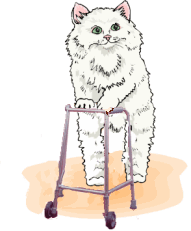Feline arthritis - introduction
Arthritis is a general term which refers to the inflammation of the joint. It is a painful disease and it should always be taken seriously. The most common signs of arthritis and joint disease in cats include stiffness, limping, or favoring a limb - particularly after sleep or resting, reluctance to jump or even climb stairs, and noticeable pain. There a a number of causes of arthritis which can be subdivided into two groups:
 |
degenerative arthritis
The most common degenerative arthritis is osteoarthritis. Osteoarthritis is damage to the joints. There is no inflammation but insteadthe disease affects the lining of the joint (cartilage) and the surrounding tissue. There is substantial damage to the cartilage and new bone grows in irregular lumps. This causes pain in the joint and stiffness. Osteoarthritis normally starts in adult cats and progesses rapidly with age.
Another form of degenerative arthritis is caused by trauma and so is named 'traumatic arthritis'. This can be caused for example by a car accident where the impact causes damage to the cat's joints.
Hip displasia is yet another degenerating condition which can affect cats (although it is much rarer in cats than dogs). Hip displasia is caused by looseness in the hip joint. This creates abnormal wear and erosion of the joint, and as a result arthritis develops. Arthritis caused by hip displasia can start at any age. It is believed to result from a deformity in the joint during the cat's development and the underlying cause may be genetic susceptibility.
inflammatory arthritis
Inflammatory arthritis has a number of underlying causes and these are listed below:
1. Infection. Infection is a common cause of joint damage. Depending on the source of infection and the organism causing the infection, this condition can either cause your cat acute lameness or a grumbling sore joint. For example, Calicivirus is better known for causing respiratory infections in cats, but it can also cause joint disease leaving the cat with some degree of lameness. However, joints most often get infected as a result of bites. The joint becomes swollen, painful, warm to the touch, and the cat will often not want to bear any weight on the affected leg. The cat often has a fever and will not eat. At times, the infection can spread from the joint to the bone (bone infection is termed 'osteomyelitis').
2. Immune-mediated arthritis also known as rheumatoid arthritis - fortunately it is not very common in cats, but it does happen. Rheumatoid arthritis is caused by an overreaction of the immune system. The trigger mechanism for RA is not fully understood but trauma or infection are defiantly strong suspects. Following the initial trigger the body overreacts and starts attacking its own joints causing damage to the cartilage and surrounding tissue. Rheumatoid arthritis is a chronic condition which progresses rapidly with age.
Note: This information is for guidance only. It is not intended to replace consultation with a licensed practitioner.

